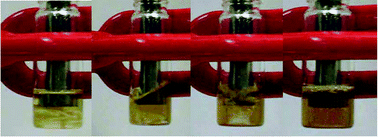Ultrasound enhancement of cellulose processing in ionic liquids: from dissolution towards functionalization†
Abstract
The ionic liquids

a
Laboratory of Industrial Chemistry, Process Chemistry Centre – Åbo Akademi University, Faculty of Technology – Åbo Akademi University, Biskopsgatan 8 - 20500 Åbo-Turku, Finland
E-mail:
jpmikkol@abo.fi
b
Laboratory of Wood and Paper Chemistry, Process Chemistry Centre – Åbo Akademi University, Faculty of Technology – Åbo Akademi University, Biskopsgatan 8 - 20500 Åbo-Turku, Finland
E-mail:
jpmikkol@abo.fi
c Mendeleev Institute of Chemical Technology, Moscow, Russia
d Zelinsky Institute of Organic Chemistry, Moscow, Russia
The ionic liquids

 Please wait while we load your content...
Something went wrong. Try again?
Please wait while we load your content...
Something went wrong. Try again?
J. Mikkola, A. Kirilin, J. Tuuf, A. Pranovich, B. Holmbom, L. M. Kustov, D. Yu. Murzin and T. Salmi, Green Chem., 2007, 9, 1229 DOI: 10.1039/B708533H
To request permission to reproduce material from this article, please go to the Copyright Clearance Center request page.
If you are an author contributing to an RSC publication, you do not need to request permission provided correct acknowledgement is given.
If you are the author of this article, you do not need to request permission to reproduce figures and diagrams provided correct acknowledgement is given. If you want to reproduce the whole article in a third-party publication (excluding your thesis/dissertation for which permission is not required) please go to the Copyright Clearance Center request page.
Read more about how to correctly acknowledge RSC content.
 Fetching data from CrossRef.
Fetching data from CrossRef.
This may take some time to load.
Loading related content
